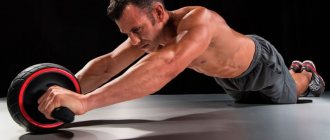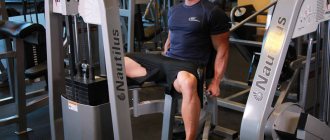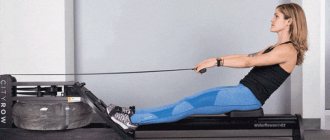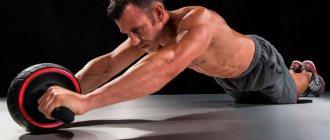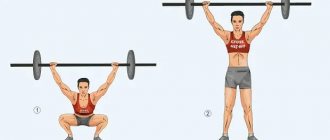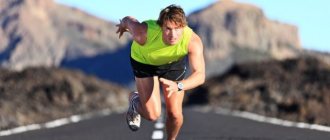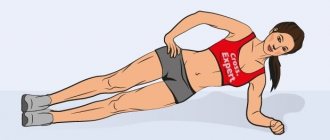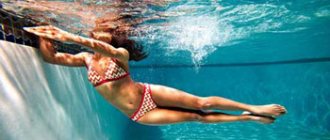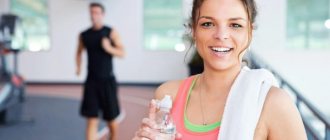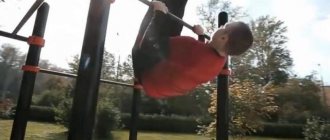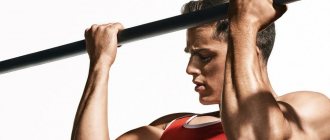The world of CrossFit is a real treasure trove of a wide variety of exercises. Athletes, striving for constant growth and progress, come up with non-standard methods of working out muscle groups. One of them is rope exercises. CrossFit training using this equipment is very popular and not in vain.
In CrossFit, you will be asked to work not with a regular rope, but with a special sports equipment with a weight at the end. Thus, the target muscle groups are subjected to an intense load, achieved by transferring inertia to the end of the projectile.
What muscles work
The enormous popularity of ropes over the past 5-10 years is due to the fact that when working with them, the muscles of the whole body work. Even with an exercise where, for example, the main movement is for the arms and shoulders, the work almost always involves:
- Back (top, middle and lower back).
- Abs (all core muscles).
- Breasts.
- Buttocks.
- Hips.
Some areas work in a static manner to maintain balance, while other muscle groups are activated in an explosive manner, performing rapid movements.
Benefits of rope climbing. Rope climbing without using legs
- Grasp the rope with both hands, one should be slightly higher than the other, bend your legs slightly or bring them out in front of you.
- Maintaining the position of your legs and body, rise up, alternately changing hands and using the latissimus dorsi and forearm muscles.
In that
If you have just recently started doing CrossFit and are not yet ready for rope climbing, start training with a lead-in exercise: pull yourself up the rope with your hands, starting the movement from a sitting position. The legs do not work, but only rest their heels on the floor. As soon as you have risen as high as possible and fully straightened your knees, begin to lower yourself down again, while the movements should be coordinated and monotonous, your palms should be removed at the same distance from each other. This will give you a good understanding of the biomechanics of movement and improve the strength of your hands and forearms.
In order to make this exercise easier for you, and to improve rope climbing, you need to separately perform the elements that make up this exercise
Pay special attention to grip strength: practice hanging on a rope, on a horizontal bar and on a towel suspended from a bar - this will strengthen your hands and forearms, and your own weight will not seem so heavy when climbing the rope.
Learn to do one-arm pull-ups, this will greatly facilitate the process of learning how to climb a rope without legs. Do pull-ups and other latissimus dorsi exercises to build your strength.
Once you have mastered at least one method of rope climbing, make this process more extreme - try to climb the rope in the shortest possible time, without resting between approaches. This way you will increase strength endurance and the overall physical potential of your body, and more complex climbing options will be easy and relaxed.
What does exercise with ropes give?
The main advantages of working with ropes:
- Development of explosive strength and the ability of muscles to contract at maximum speed.
- Involvement of a huge number of muscle fibers (maximum complex and volumetric movements).
- Speed and coordination training.
- Improved neuromuscular connection.
- Development of endurance (due to which ropes are popular not only in CrossFit, but also in any contact sports).
- Engagement of stabilizer muscles.
- Well suited for functional training and fat burning due to huge energy consumption and calorie consumption.
The ropes themselves do not provide much growth in muscle mass when it comes to hypertrophy. But if the main goal is the development of hardy, natural muscles that are involved in work as quickly as possible, then ropes will be an excellent choice.
Training (sports) rope
To feel the full power of this simulator, just a couple of exercises would be enough. But…. variety is what makes the training process fun. With a little creativity, the rope can become one of your favorite exercises in the gym.
The basic movements with a rope are creating a wave. The complexity and variety of exercises is created by different body positions and different grips. The advantage of training with a rope is that when performing exercises, the muscles of the entire body are in constant tension and active work. The body is not given the opportunity to relax and adapt to the monotonous load.
The distribution of the load throughout the body depends on how the exercise is performed. With training ropes, you can conduct a full-fledged workout to develop strength and endurance of different muscle groups at the same time - arms, legs, shoulder torso, abs, back. Burn more calories, gain muscle mass, improve functional strength - it's all possible with CrossFit ropes. In addition, sports ropes are a powerful tool for cardio training and strengthening the cardiovascular system. With such training you get tired instantly, but at the same time the muscles are worked out very well.
Perform each of the following exercises for a specific period of time. Beginners should start with 15 to 25 seconds per movement, and if you are a more advanced athlete, challenge yourself for 30 to 45 seconds.
1. Alternating waves in a half-squat.
Bend your legs into a half-squat position, pushing your hips back as if you were about to sit in a chair. Place your body weight on your heels and keep your chest upright.
Forcefully swing your arms up and down below your knees to get maximum power. Try to maintain consistent waves throughout the movement. Vary the waves from large to small by changing the amplitude of the vertical movement of the rope. Small, fast waves are aimed more at working the arm muscles. Larger waves will help increase overall power due to more active work of the body.
2. Double wave.
The starting position is the same as in the previous exercise. But now we move our arms up/down simultaneously, trying to maintain the wave throughout the entire exercise. Again, we alternate small waves with large ones either in one approach or in separate ones. Similar to the previous movement, the smaller and faster the waves, the faster the speed of the fast-twitch muscles. Big waves will help work the entire core and develop strength.
3. Jumping with powerful claps.
This intense plyometric rope exercise will improve your explosiveness.
Making sure that the rope is loose and not tight, jump up from a half-squat position, while taking a deep breath and swinging your arms with the rope above your head as much as possible. And, landing again on your haunches, as you exhale, slam the rope on the floor with maximum force.
It is important to breathe correctly during the exercise, because... this helps strengthen your core muscles. Perform this exercise several times according to the instructions provided.
4. Rotation from side to side.
The target of this exercise is the core and leg muscles.
Holding the ropes in your lowered hands at your right hip, forcefully move the rope towards your left thigh. At the same time, turning the right leg and knee inward. As soon as the rope reaches the floor, immediately send the rope through the body back to the right hip, turning the left leg and knee inward. Generate strength and power from the floor up through your legs, core and arms.
5. Complicate the previous exercise.
Lunge with your left leg at a 90-degree angle. The right one is extended back slightly above the floor. The body is straight. While holding the position, throw the rope over your left knee from side to side continuously. Perform the next approach on the other leg. In this exercise, the load on the leg muscles is even greater. In addition, the stabilizer muscles that keep you in balance are under load.
6. Standing rope throw.
Try the option of jumping with the additional resistance of a sports rope , which, first of all, will force the muscles of the shoulders, back, arms and legs to work in an enhanced mode.
Starting position: feet shoulder-width apart, rope loosened. Make sure the position is stable. The strength coming from your legs will help you raise your arms with the rope high above your head and throw it down.
If you are unable to use your legs, this exercise will be much more difficult than it should be. Then try to do the entire movement once, and then prepare yourself for the next repetition.
7. Jumping with alternating waves.
Before you begin, concentrate on the position of your legs. This is important for maximum strength and stability throughout the exercise.
Perform jumps with alternating legs, landing on a bent leg in a forward lunge. At the same time, the arms move up/down, clapping the rope on the floor.
Start slowly until you are able to control the entire stroke. Once you have mastered it, you can increase your speed by repeating the jumps without intermediate pauses.
8. Exercise to work the upper body and core.
Feet shoulder width apart. While inhaling, swing your arms with the rope over your head, throw it down, squat down, resting your hands on the floor with the rope, exhale, throw your legs back into the plank position. Then we jump to bring our legs back to our hands and stand up to repeat.
9. Running in place.
This exercise is great for improving your agility. Running forward/backward with light, quick steps on your toes while simultaneously raising your arms up/down, forming waves. Change the amplitude of the waves to short/long. Try to maintain movement with the rope at a distance of about 3 meters.
10. Throws while sitting.
This exercise is performed while sitting. Start in a position with your heels touching the floor. Turning your body from side to side, throw the rope from one side to the other, through your legs. The head is slightly tilted forward, the chin is down. In this exercise, the muscles of the shoulder and abdominal muscles work intensely. To complicate the exercise, try doing the same thing, but with your legs torn off a few cm from the floor surface. This is not an easy task!
11. Plank with a wave.
The next exercise is for advanced athletes.
Challenge your abs and arms with a challenging exercise for both strength and balance.
Starting position – “plank”, leaning on the floor with one hand, holding the rope in the other. Keep your feet shoulder-width apart and place your weight in your heels for greater stability. The spine is straight. Once you have established the correct plank position, begin moving your arm sideways at a fast pace.
Don't let your hips sag or tilt to the side. Imagine that you have a glass of water sitting on your lower back and you don't want to spill it. This way you keep your hip level. Repeat the exercise with the other hand for the same period of time.
12. Side plank with rope.
The oblique and transverse abdominal muscles are extremely important, but they are not always given due attention. The side plank is a phenomenal rope exercise for training these muscles. Tie one end of the rope to a weight and leave it at the far end of the room. Pull the rope and at the other end, free from the weight, stand in a side “plank”, leaning on your elbow. Take the rope in your free hand and pull it behind your back until the other end with the weight is near you. Then pull the loaded end again to the far corner, change the bar to the other side.
During the exercise, monitor the position of the body, do not allow it to sag or lean forward.
Functional training with CrossFit ropes is recommended for sports teams of Football, Hockey, Rugby and anyone who needs tools for powerful training.
Recommendations
Rope training is as flexible as possible. You can ensure load progression in the following ways:
- By the number of swings (repetitions) in the approach, but for such work only multi-repetition sets are effective. That is, from 20 repetitions and above.
- Timed is a particularly useful mode for developing explosive strength (for example, using the Tabata protocol).
- Until failure or complete fatigue.
For maximum effectiveness, it is recommended to use exercises with ropes in a separate workout, for example, choosing one complex for 5-15 minutes (depending on your level of training). However, they can also be effectively combined with any other types of training: machines, free weights, crossfit training and others.
Who is recommended to perform such training?
Almost all people can participate in such a program. These classes are suitable for people who:
- They want to lose weight quickly and not lose muscle mass. But at the same time, people who are obese are advised to first consult with a specialist, since many people with large body weight have problems with the heart and blood vessels.
- They want to pump up muscle tissue and tighten their figure.
- They want to increase their endurance and improve their health.
CrossFit can be practiced by both advanced athletes, teenagers and older people. However, you should correctly introduce CrossFit into your life, since the body of minors and the elderly is much weaker and more vulnerable than that of an adult. Therefore, they should simply reduce the load and take a break during the CrossFit workout.
Those who work out in the gym are advised to seek advice from a specialist, and at first train under supervision.
After all, despite the fact that doing the exercise seems simple, in reality it is quite difficult to do, and at first you will need advice from experienced people.
Interesting: How to start doing pull-ups on the horizontal bar?
How to choose a rope for CrossFit
Almost all ropes are relatively standard, so only those models that are not originally intended for crossfit or functional training (for example, school equipment) can differ.
When choosing, the following criteria are taken into account:
- Length – the longer, the stronger the load.
- Flexibility – necessary for transferring force (heavy ropes not intended for such work will slow down the athlete).
- Weight – the heavier, the greater the load.
- Material – mainly determines the wear resistance and service life of the projectile.
The standard weight for CrossFit is 40-48 mm in diameter, which allows you to get a specific weight of 0.5 kg per meter. In this case, you can easily track progress due to the length of the projectile used.
Length standards:
- 9 m – beginners and girls with zero level of physical training.
- 12 m – beginners and girls with training experience.
- 15 m – women with a high level of physical fitness, men with training experience.
- 20 m – advanced and professional level athletes.
- 25 m – top athletes, strongmen, etc.
When choosing, you can give preference to both products made from natural materials and modern synthetic analogues, which are in no way inferior and often have greater wear resistance.
Crossfit Workout: Squeeze with Rope
6. Vigorously lowering the rope - stand at a small step and hold the ropes. Raise your arms high and lower down so that the ropes fall to the ground. Lower your entire body into a high squat.
7. Vigorous lowering with alternating ropes is a similar exercise. The difference is that the hands are raised alternately. When one rope falls to the ground, the other is still high in the air.
8. Pulling the rope from side to side - stand at a small step, carefully bend your knees and hold the rope with both hands. In this case, the rope will be pulled sideways. Start by moving the rope to the left side of your body. Raise your arms up and press the rope to the right side of your body. Exercises alternately on both sides.
What is suspension training?
During such training, special TRX suspension loops, developed by Navy SEAL, are used. Randy Hetrick, founder of TRX, had to stay in great shape for his job, but he often had to travel, so it was difficult for him to train well with traditional fitness equipment.
As a result, he made the first suspension trainer from scrap materials and parts of an old parachute. And his team has developed a large number of exercises using this equipment. They took gravity and body weight into account to create the ultimate full-body workout that develops strength, balance, coordination, flexibility and core strength.
Test of strength
Test children's series of rope trainers with the weight of an adult with a small swing amplitude - without excessive enthusiasm, so as not to overstretch the knots.
Professional series can be tested with your own weight, then add jerks and if all is well, then test with the weight of two or three people.
During the first week of use, inspect the condition of the bracket every day to ensure that there are no gaps between the bracket and the surface where it is attached with an anchor, and then at least once a month.
Maximum benefits from training with minimal effort
One of the biggest benefits of loops is their incredible ability to modify exercises for beginners or add complexity for professionals. You can choose exercises that are right for you. Here are some ways you can turn a beginner's workout into a more challenging workout as you get stronger and fitter.
How to achieve success and progress with TRX:
Change the position of your legs from wide to narrow or even perform on one leg
The wider your legs are, the stronger and more stable the base for performing the exercises. If you make the distance between your legs smaller or perform exercises while standing on one leg, then your core muscles will work harder to prevent body rotation and maintain balance. Once you get to the point of performing single-leg exercises, you can change the position of your free leg to make the exercise even more challenging and test your coordination. Here are some options: raise your knee, extend your straight leg forward and keep it in the air, or move your raised leg to the side.
Change your body angle to change the resistance
The more horizontal the body is to the floor, the more difficult the exercise becomes. This approach to performing the exercise will force you to work against your body weight and gravity, increasing resistance. To make the exercise easier, assume an upright position. This will reduce resistance and allow you to focus on the technique of performing the exercise.
Change the pace
Move faster to get your heart rate up. With this approach, the workout takes on the features of cardio and also increases muscle endurance. You can either perform a certain number of sets and repetitions at a fast pace, or monitor the number of repetitions completed in one minute.
Shorten the break between exercises
Try to perform one exercise after another without resting. This will also improve muscle endurance.
Add Plyometrics
To increase the intensity of your workout, add jumping jacks to your regular exercises (jumping jacks, squats). This will add a touch of cardio to your workout.
These were the easiest and fastest ways to make your loop workout harder in just a few seconds. You can also add more challenging exercises to your workout to increase the intensity.
Bracket installation
If you have a hammer drill, a drill and experience in using it, then securing the brackets will not be difficult:
1. Attach the bracket to the place where it should be located and circle the holes with a pencil.
2. Drill holes according to the diameter and length of the anchor, clean the hole. Try the bracket again - the holes should match.
3. The holes in two and three anchor brackets are smaller than the fastening part of the anchor (for reliability), so insert the anchors into the bracket and then into the holes. Tighten the bolts with sufficient torque.
If you do not want to install it yourself, then use the services of a specialist, a fitter, who will install the bracket according to these instructions. Monitor his work.
